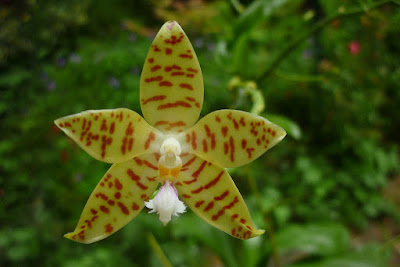Pale Colored Phalaenopsis is native to the Philippines. It was met near Manila and near Puerto Princesa on the island of Palawan, at an altitude of 0-457 m above sea level.
Phalaenopsis pallens orchid, also called as Pale Colored Phalaenopsis, Phalaenopsis denticulate, Phalaenopsis foestermannii, Phalaenopsis lueddemannia var. pallens, Phalaenopsis mariae var. alba, Phalaenopsis mariae var alba, Phalaenopsis pallens f. alba, Phalaenopsis pallens f. fourmaniana, Phalaenopsis pallens var. alba, Phalaenopsis pallens var. pallens, Phalaenopsis pallens var. trullifera, Polychilos pallens, Stauropsis pallens, Trichoglottis pallens, is a species of the genus Phalaenopsis. This species was described by (Lindley) Rchb.f in 1864.
IDENTIFY PHALAENOPSIS PALLENS ORCHID
Pale Colored Phalaenopsis is native to the Philippines. It was met near Manila and near Puerto Princesa on the island of Palawan, at an altitude of 0-457 m above sea level.
It is a dwarf, hot growing epiphytic with the short stem is covered by distichous, leaf-bases carrying distichous, elliptic to obovate, fleshy, drooping, rounded or obtuse and obscurely unequally bilobed apically leaves. The leaves are 13-18 cm long.
Phalaenopsis pallens blooms on a lateral, slender, 5 to 7" (12 to 17 cm) long, racemose or paniculate, one to few (4) flowered inflorescence that is shorter than the leaves, and has a fractiflex rachis with small ovate-triangular, acute bracts with somewhat delicate, waxy flowers occuring in the fall, winter and early spring. The star-shaped flowers are 4-5 cm in diameter. The petals of both whorls are white to pale yellow-green with darker stripes, but the colors paler towards the center, turning almost to white. The lip is white and has yellow spots. After the last blossom fades, the stalk remains, and as long as it is green should not be cut off as it will bear flowers again the following winter.
Phalaenopsis pallens is similar to P. lueddemanniana but is distinguished by the callus which has 2 forward facing bifid projections, one in front of the other.
GROW AND CARE PHALAENOPSIS PALLENS ORCHID
Cultural information should only be used as a guide, and should be to be adapted to suit you. Your physical location; where you grow your plants, how much time you have to devote to their care, and many other factors, will need to be taken into account. Only then can you decide on the cultural methods that best suit you and your plants.
Light:
Phalaenopsis pallens requires bright filtered light for good growth and flowering. A light level of 10000-12000 lux is recommended. Dark green leaves usually mean light levels are too low.
Temperature:
It is a thermophilic plant. The average temperature of the day throughout the year is 31-33 ° C, night 23-24 ° C, with a summer daily amplitude of 7-8 ° C.
Humidity:
This species needs the humidity level of 80-85%. Provide high humidity and ample air circulation to prevent rot.
Substrate, growing media and repotting:
Pale Colored Phalaenopsis grows best mounted on a tree trunk, cork slab or nestled in a slatted basket or pot. Containers should be filled with is a bark with a grain size of 12-16 mm with the addition of humectants, or sphagnum moss with the addition of pearlite or charcoal to improve drainage. The addition of charcoal seems to improve the condition of the plant. It may also be advantageous to add a small amount of limestone, but under the condition of watering with warm water (21 ° C).
Do not repot it while it is in bloom, repotting is best done just after flowering, when the growth of new roots begins.
Watering:
From spring to fall, water frequently but only when the plant and bark are dry to the touch. Hot water at 21 ° C is recommended for watering. The precipitation scheme is wet / dry, with the period of winter being a relatively dry period.
Fertilizer:
In the period of active growth, it is recommended to apply once a week or once every two weeks 1/4-1/2 of the recommended dose of fertilizer for orchids.
Rest period:
In winter, the average day temperature is 31-32 ° C, the night 23 ° C, which gives a daily difference of 8-9 ° C. The amount of water should be limited to light watering only every 2-3 weeks and occasional fogging between watering. Do not allow the plant to dry completely, because during this period flowering occurs. It is necessary to eliminate fertilization and increase the amount of light.















Thank you
Delete